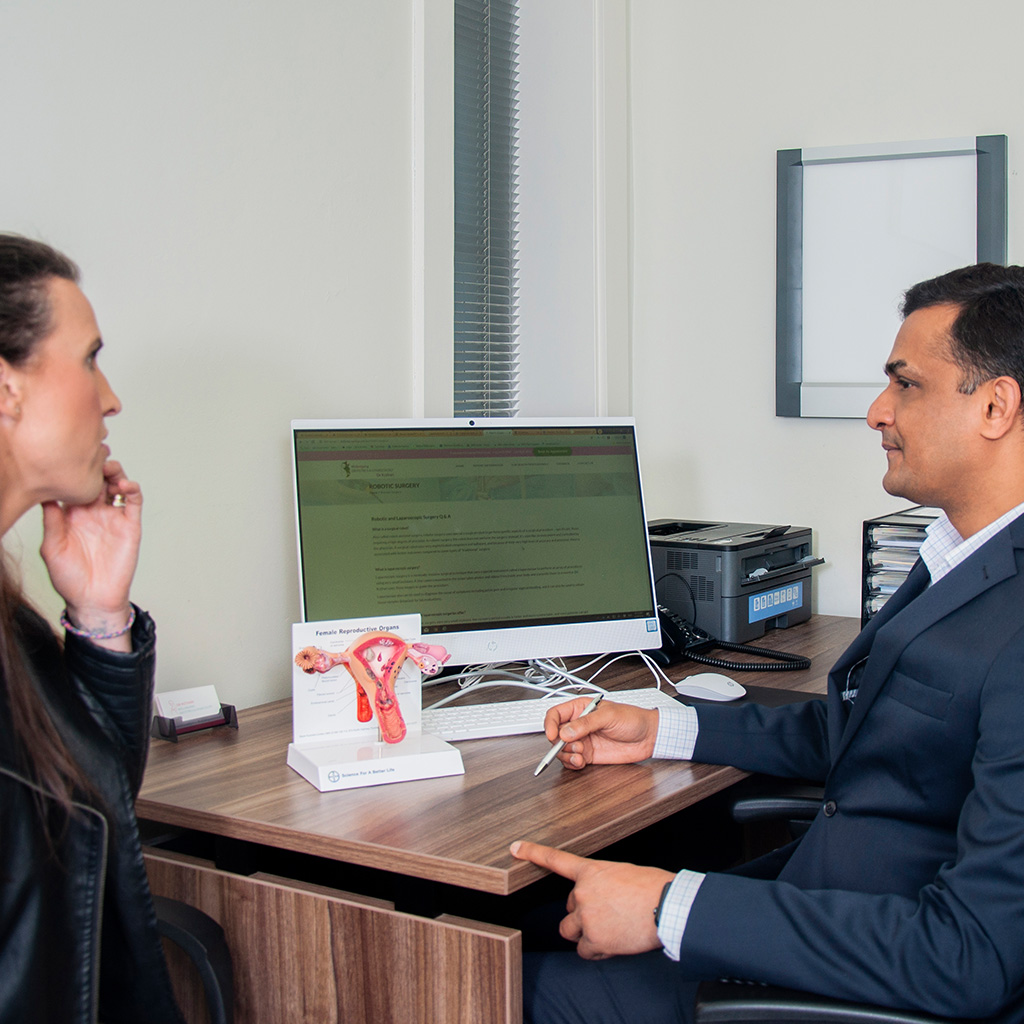Hysterectomy
What is a hysterectomy?
A hysterectomy is an operation to remove the uterus, and sometimes accompanying organs such as the cervix, fallopian tubes and ovaries during the same operation.
Hysterectomies are commonly performed to treat a number of conditions that Australian women are likely to experience, such as fibroids, heavy bleeding, endometriosis, adenomyosis, uterine prolapse and cancer. As it is considered a major surgery, Dr Kothari will first explore other treatment options available.
A hysterectomy should be considered for those who have been unsuccessful with other treatment options and fully understand the risks involved. Dr Kothari will discuss these risks, the benefits associated with a hysterectomy and the different types of surgery at your consultation.


What type of hysterectomy is recommended?
- Hysterectomy with ovarian conservation – Sometimes known as a total hysterectomy, this type of surgery involves the removal of the uterus, cervix, fallopian tubes, and the preservation of the ovaries.
- Hysterectomy with oophorectomy - This involves the removal of the uterus, cervix, fallopian tubes, and one or both sets of ovaries.
- Radical or Wertheim's hysterectomy – This type of surgery is used in the treatment of some gynaecological cancer cases, and involves the removal of the uterus, cervix, fallopian tubes, ovaries, nearby lymph nodes, and upper portion of the vagina.
- Sub-total or partial hysterectomy – This type of surgery is the least common in Australia, which involves removing the upper two-thirds of the uterus, the fallopian tubes, and the preservation of the cervix.
What are the methods of a hysterectomy?
To perform a hysterectomy, a surgeon can choose between three different methods. This choice will depend on the patient’s characteristics, such as weight, pelvic surgery history, and previous pregnancies. Dr Kothari will utilise this information along with experience and skills in order to recommend one of four key methods, as detailed below.
- Abdominal hysterectomy – This is where an incision is made either horizontally above the pubic hairline (bikini line) or vertically from the navel to the pubic hairline. It is most commonly opted when the patient has cancer, an enlarged uterus, is obese, or has large fibroids, extensive adhesions or endometriosis. An abdominal hysterectomy has a lower chance of damage to the urinary tract and blood vessels, but it generally more painful.
- Laparoscopic hysterectomy – This type of operation is performed by making small incisions in the abdomen and then inserting a laparoscope. With the insertion of a camera, this surgical instrument allows Dr Kothari to view the interior of the abdominal cavity. Additional surgical instruments are then inserted through the remaining incisions to complete the surgery with the aid of a video screen. The advantage of a laparoscopic hysterectomy is a faster recovery time, but it does increase some risks, such as damage to the urinary tract.
- Vaginal hysterectomy – This surgery involves making an incision in the upper portion of the vagina and removing the uterus through the vagina. A vagina hysterectomy is mostly recommended for non-cancerous conditions, with the advantage of being generally less painful.
- Robotic hysterectomy. This is a procedure that is performed by Dr Khotari using the latest and most up to date technology. He will be able to discuss your suitability for this option at your consultation.
Are there any risks with getting a hysterectomy?
As with most types of surgeries, the risks associated with a hysterectomy depend on a number of factors relating to the patient’s overall health and the type of surgery performed. The most common complications for a hysterectomy are post-operative fever and infection. Other serious problems include haemorrhage, blood clot in the lungs, damage to surrounding organs during surgery and urinary issues.
There is also the more serious risk of vaginal vault prolapse following a hysterectomy. This occurs when the upper area of the vagina drops down or loses shape due to a reduction in support structures, which then may require further corrective surgery.
It is important that you are properly informed about the different risks and complications that may arise during and/or after a hysterectomy. Dr Kothari will discuss any concerns you may have before opting for this type of surgery.
